Kilimanjaro porters and guides are the good folk that get people like you and me to the top of Mt Kilimanjaro.
Depending on your group size, there are around 4 support crew per trekker on the average Kilimanjaro trek.
In this article I share information about Kilimanjaro porters and guides. Specifically, what the Kilimanjaro porter welfare system looks like and how you can contribute to a more ethical outcome.
My Quick Takeaways:
Planning to climb Mount Kilimanjaro? Here's a brief guide on tipping your support team:
Please note that tipping is customary. It's standard practice to tip your guides, porters, and cooks as a gesture of appreciation for their hard work during the trek.
Suggested Tipping Rates:
- Lead Guide: $20–$25 per day
- Assistant Guide: $15–$20 per day
- Cook: $15 per day
- Porter: $10 per day
Example Calculation: For a 6-day trek with one trekker, the total tip would be approximately $330–$420, covering the entire support team.
- When to Tip: Tips are usually given at the end of the trek, often during a tipping ceremony at the final campsite or after descending to the base.
- How to Distribute Tips: It's advisable to prepare individual envelopes for each team member. Some tour operators may suggest pooling tips to be distributed by the lead guide; confirm the preferred method with your operator.
Tipping is a meaningful way to acknowledge the dedication and hard work of your Kilimanjaro support crew, ensuring they receive fair compensation for their invaluable assistance.
Now, let's dive a bit deeper and learn more about the porters and guides on Mount Kilimanjaro. Ready? Let's rock.
Kilimanjaro Porters - A Brief Overview
Why do you need porters on Kilimanjaro?
As mentioned above, for every hiker on a Kilimanjaro trip, there are about 4 porters going up the mountain as part of the support team.
Why so many?
Apart from the Marangu route that has hut accommodation, all other treks on Mt Kilimanjaro are camping expeditions.
This means everything, from tents, tables and chairs to cooking utensils, kerosene gas and often toilets, need to be carried up the mountain.
This heavy work is done by Kilimanjaro porters.
The Bigger Picture- Tanzania's Tourist Economy
Due to the growing popularity of trekking Mount Kilimanjaro, the mountain has in effect become a significant component of the local economies in Moshi and Arusha.
With this growing interest in trekking Kilimanjaro, local and international tour companies have proliferated and local residents in these towns have flocked to the mountain in desperate need of work.
Unemployment is high in Tanzania and hence there is no shortage of people willing to do literally anything to earn a wage, albeit tiny.
Please take a few minutes to watch this video on the Porters of Kilimanjaro.
Porter Welfare on Kilimanjaro
In the last few years, Kilimanjaro National Parks Authority (KINAPA) implemented regulations to improve the management of the mountain and conduct of tour operators.
However, historically this has been poorly regulated and monitored.
Because of this, the minimum wage set by KINAPA was often not met by many of the local operators.
Some paying as little as $2-$3 a day to their porters. Take a second to let that settle in. That’s less than the price of a Starbucks coffee to carry around 20kg of your gear up a very high and rather dangerous mountain!
In recent years, multiple organisations have formed to protect the rights of porters on the mountain.
This is in addition to Kilimanjaro Porters Assistance Project, run by Karen Valenti who does an incredible job and can be credited with starting this movement.
Porters on Kilimanjaro must register with an association in order to work . In the event of unfair treatment, the porters can report the trekking company to the organisation who are able to implement legal action.
Although things are looking better with these organisations as well as raised client awareness, it's difficult to judge the effectiveness of the system.
There is still room for improvement and the market for porters and guides is still open to exploitation.
In a perfect world, porters and guides should be paid a sufficient mandatory wage that is strictly enforced.
However this is not the case and therefore tipping on Kilimanjaro is customary and standard, but often very confusing in terms of working out how much to give each support team member.
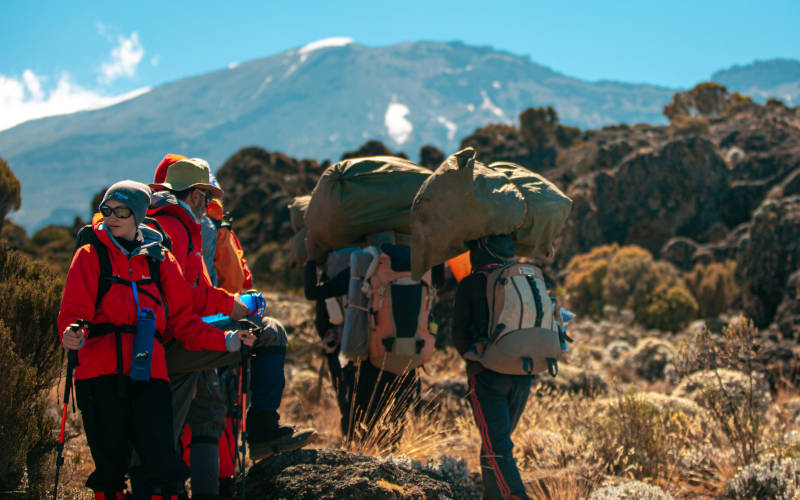
Porters carrying gear on Mount Kilimanjaro.
Kilimanjaro Guides and Porters
What do support crews on Mt Kilimanjaro do?
Before you begin your climb you will meet your guide and porters. Typically guides can speak good English, porters less so.
Porters carry all your gear (excluding your daypack) and all the equipment you need on your climb (tents, cooking equipment, food, water etc.).
Each porter carries up to 20kg on their back or head! Yes, 20kg.
Some tour operators limit the weight that porters carry to 15kg.
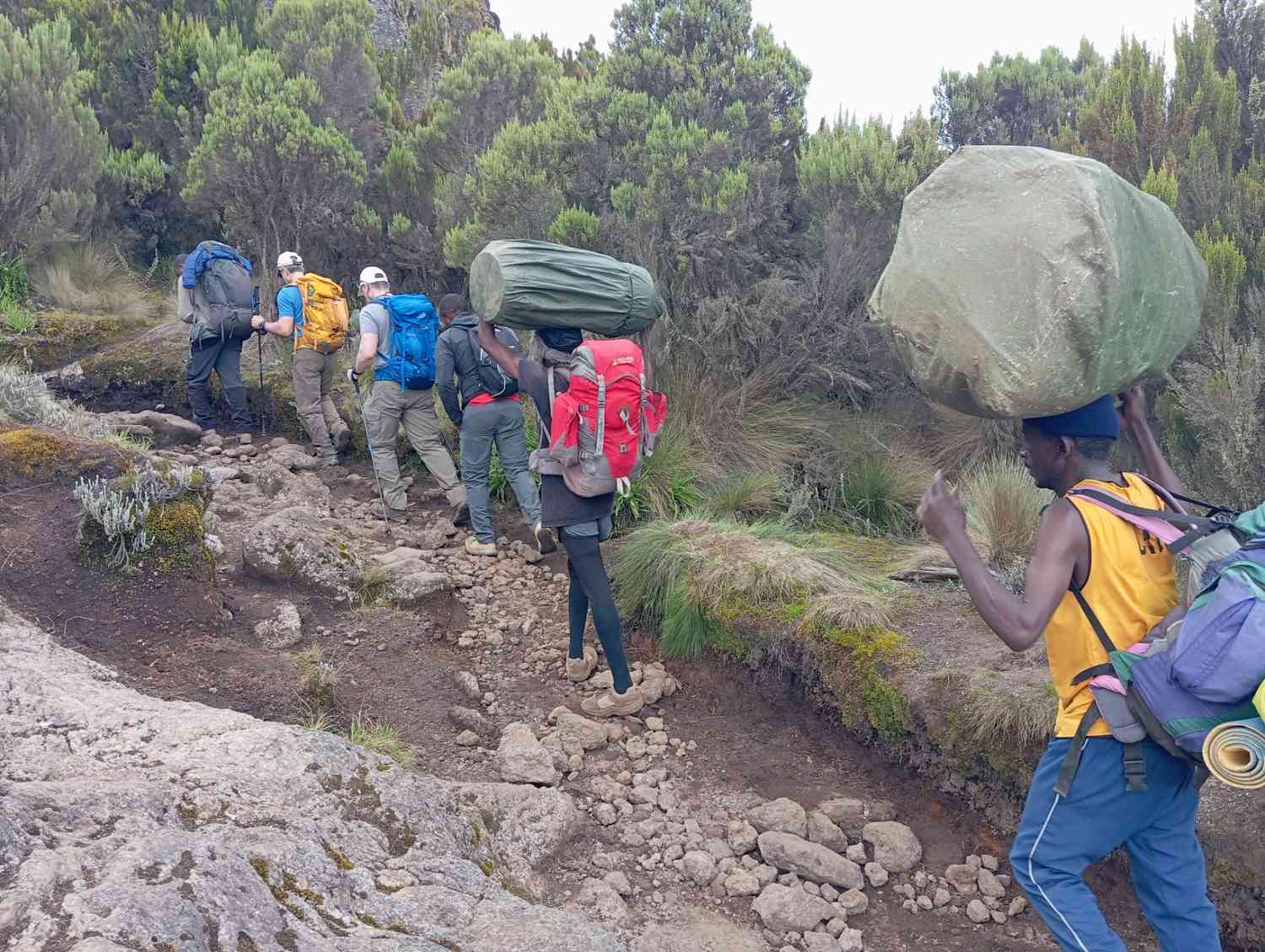
The porters on Kilimanjaro are completely acclimatised and hike at speed between camps, despite their heavy loads.
Note: new regulations mean that guides and cooks are not allowed to carry any weight apart from their own gear.
Porters race ahead of you and your guide to make sure they get to each Kilimanjaro campsite before you and have everything setup for your arrival (tent assembled, food ready etc.).
Guides are responsible for managing the porter team and ensuring you have a safe and enjoyable hike. Most are fully trained in mountain first aid, and have many Kilimanjaro summits under their belt.
What is the ratio of support staff to trekkers?
The average ratio of support staff is 3 porters for every climber, 2 guides for every 4 climbers, cook and assistant guides vary depending on numbers.
Here are some typical ration numbers:
- 1 Client = 1 Guide/ 1 Cook/ 6 Porters
- 2-4 Clients = 1 Chief Guide/ 1 Assistant Guide/ 1 Cook/ 6-10 Porters
- 5-7 Clients = 1 Chief Guide/ 2 Assistant Guides/ 1 Cook/ 10-14 Porters
- 8-10 Clients = 1 Chief Guide/ 3 Assistant Guides/ 1 Cook/ 16-20 Porters
Note: Numbers vary depending on the tour company you use. The best companies have a high guide to client ratio.
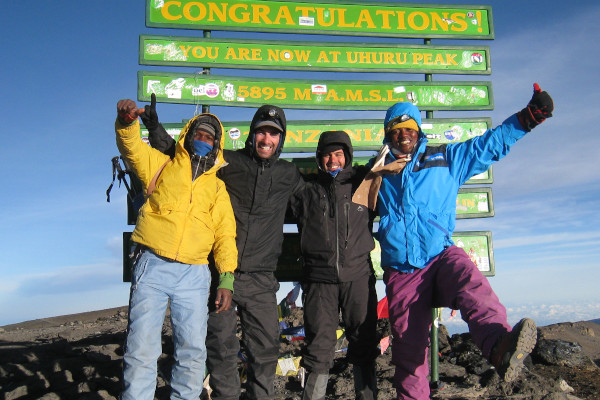
Plan your Kilimanjaro trek
Get a quote from my recommended local Kilimanjaro operator
How much should you tip Kilimanjaro porters and guides?
As mentioned earlier, tipping is customary on Mt Kilimanjaro.
I've provided a guideline and worked example for calculating how much you should set aside for tips. I encourage using this as a guideline only.
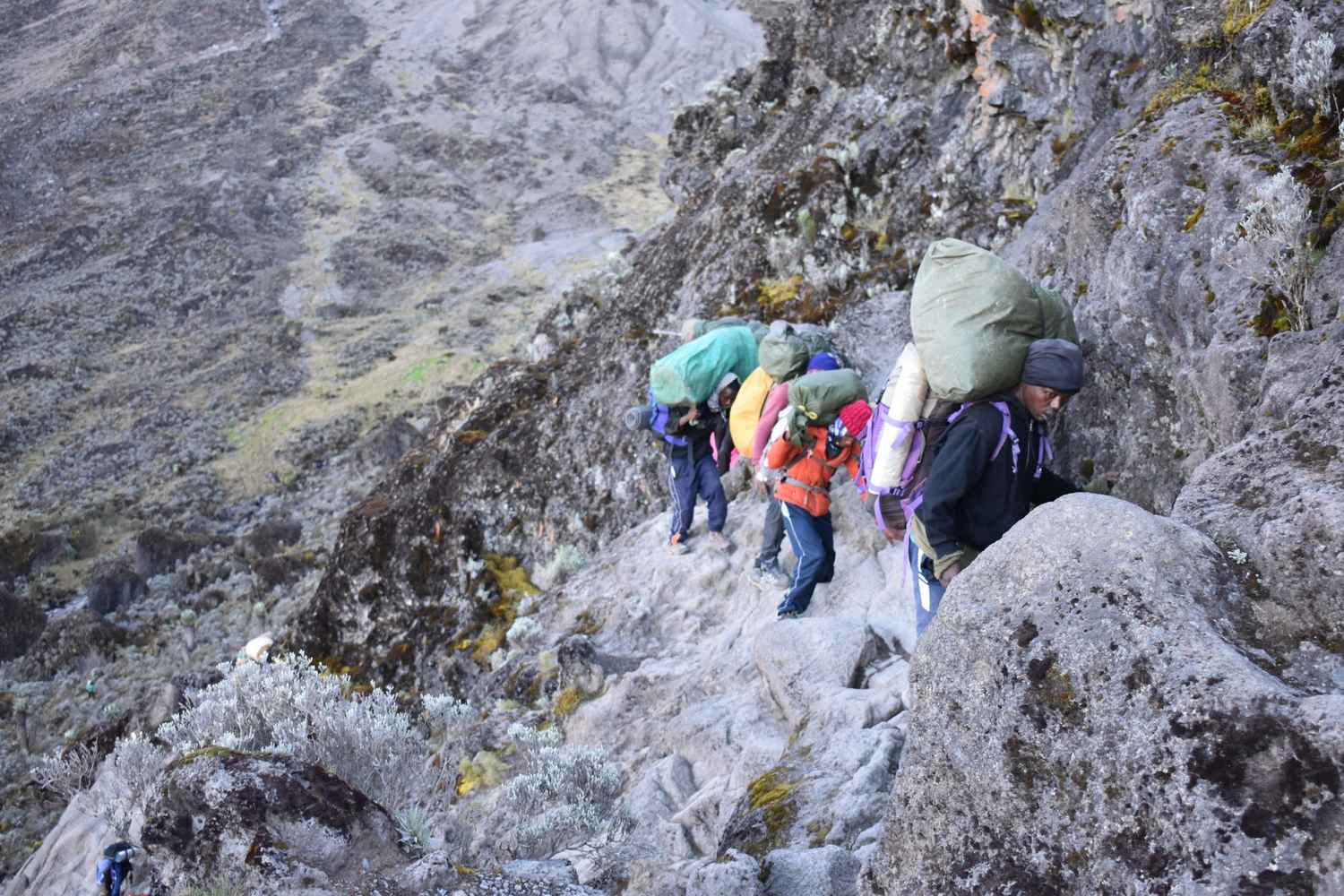
Porter's work is extremely physical, we advise setting aside a little extra for your tip as a token of gratitude.
My numbers are 10-20% more than many of the other tipping numbers you might find online. This is because I believe that anyone who can afford to trek Kilimanjaro as a leisure activity, can also afford to pay that little bit more to their support crew.
What do you think?
Tipping amounts are as follows. These numbers are per group, not per climber.
- Per main guide – US$20-25 per day
- Per assistant guide – US$15-20 per day
- Per cook – US$15 per day
- Per porter – US$10 per day
Can you provide an example for tipping on Kilimanjaro?
Yes, for a 6 day trek the total tipping value per group and climber would look as follows.
Tips vary by support crew size, which varies by tour operator. So the table below is just a guideline. If in doubt, I recommend working on 10-15% of what you paid for your trek.
Support Crew | 1 Trekker | 2-3 Trekkers | 3-4 Trekkers | 4-5 Trekkers |
|---|---|---|---|---|
Guides | $120-$150 | $120-$150 | $240-$300 | $240-$300 |
Assistant Guides | - | $90-$120 | $90-$120 | $90-$120 |
Cooks | $90 | $90 | $180 | $180 |
Porters | $120-180 | $300-360 | $480-$540 | $840-$900 |
Total for Group | $330-$420 | $600-720 | $990-$1140 | $1350-$1500 |
Per Trekker | $330-$420 | $200-$360 | $250-$380 | $270-375 |
When and who do you pay your tip to?
Tips are usually paid at the end of your Kilimanjaro hike after you have reached your final checkpoint and signed out with the authorities.
It is customary to pay tips individually in separate envelopes unless advised otherwise (some tour companies suggest you pay your lead guide who then re-distributes the money).
Please check with your trek operator what their preferred practice is.
Also, some operators suggest that you give your tips at the last meal on the mountain. Unless expressly asked to do this by your tour operator I suggest waiting to distribute tips at the end of your trek.

Plan your Kilimanjaro trek
Get a quote from my recommended local Kilimanjaro operator
What other ways I can make a difference to the porters on Kilimanjaro?
Other things you can do too help support the welfare of Kilimanjaro porters:
- Make sure you choose a trek operator that is a member of KPAP. You can then be sure that porters on your trek are treated well, get appropriate gear and food, and are paid a fair salary.
- In addition to tips, you can give some of your gear to porters after your trek. A water bottle, warm beanie or pair of gloves goes a long way.
- The Kilimanjaro Guide Scholarship Foundation can assist you in arranging a scholarship. These scholarships range from 8 week “rainy season” courses to full year courses.
My Final Thoughts
And there you have it: A quick and easy guide on the Kilimajaro porters and guides and how much you should tip them. Let me know in the comments how you tipped your porters and guides on Kili. Let's share the love.
Check out my other helpful climbing Keilimanjaro guides:

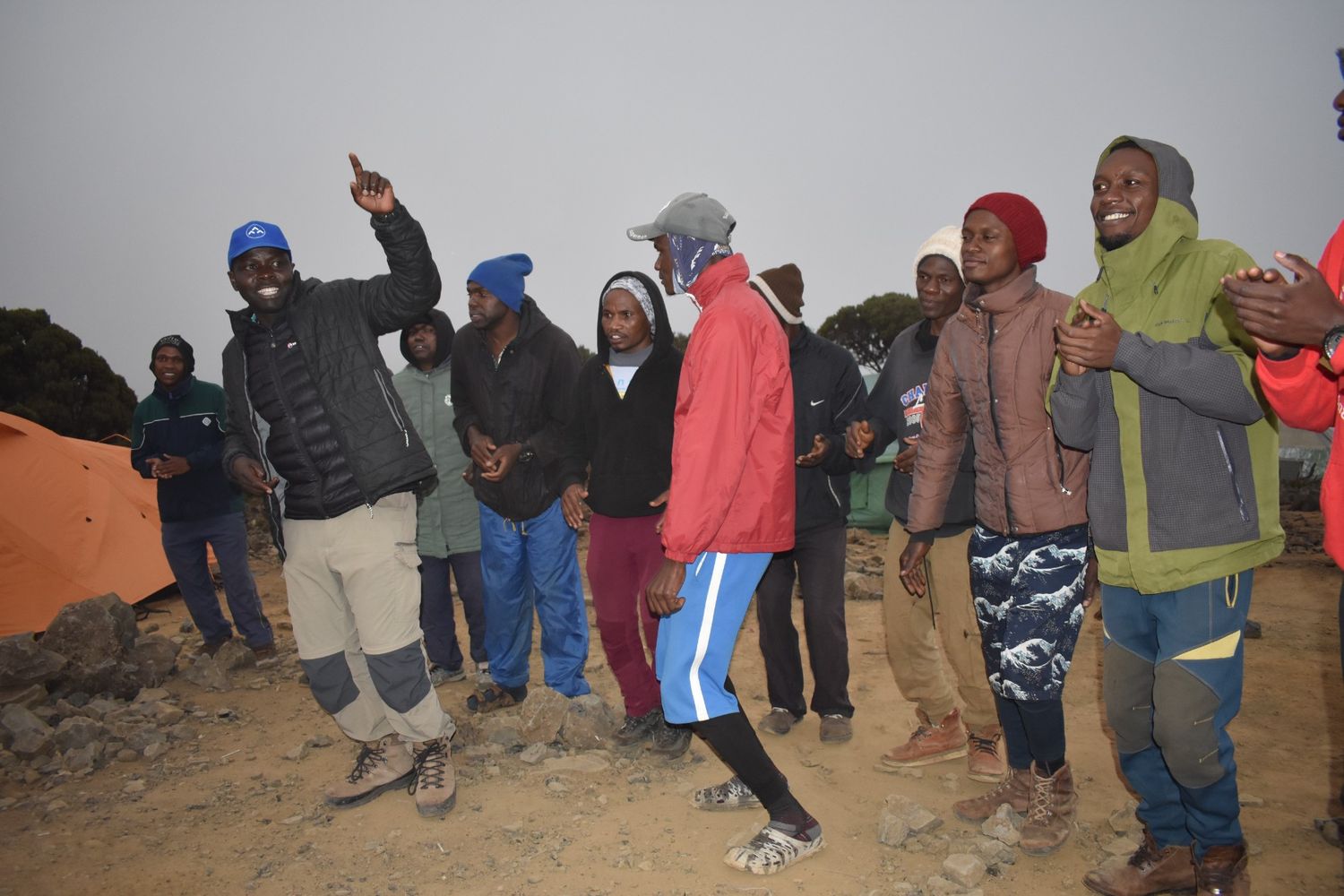
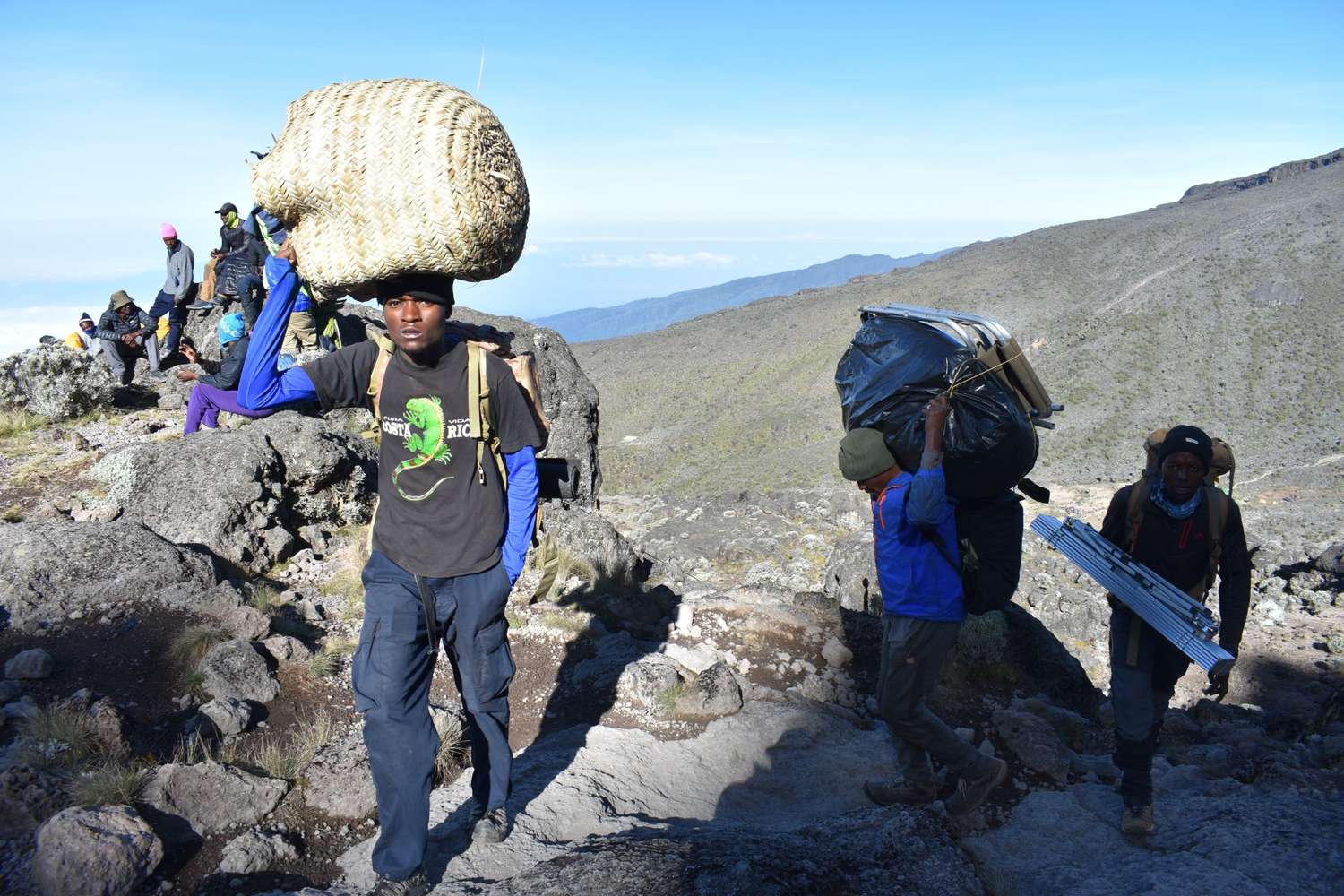
Hi Mark,
Methley here from Just-Kilimanjaro. I was searching for information and I came across your very informative website.
Some corrections:
Guide:Client ratio are as per Kilimanjaro National Park rules:
1 Client = 1 Guide/ 1 Cook/ 6 Porters (3 porters cannot carry all the food and equipment for themselves and for the client)
2-4 Clients = 1 Chief Guide/ 1 Assistant Guide/ 1 Cook/ 6-10 Porters
5-7 Clients = 1 Chief Guide/ 2 Assistant Guides/ 1 Cook/ 10-14 Porters
8-10 Clients = 1 Chief Guide/ 3 Assistant Guides/ 1 Cook/ 16-20 Porters
Thanks for the correction, we’ve updated the article.
Thanks for you wonderful tips about Kilimanjaro climb,you doing amaizing job guys and we apreciate
I want to make only one day trip to mandara I need one guide no need for cook or porter so how much it will cost me?
A group of my friends just got back from Kilimanjaro and had a bad experience.
The group was 8 people and budgeted $300 tip each, $2,400 total after reading articles about the suggested level of tipping.
However, the guide insisted that $600 should be paid and as we didn’t have much extra money, only around $100 or so, all of the money was snatched and left everyone feeling upset and sad.
I don’t know if this has happened to any other groups and I hope that it hasn’t, but maybe if people could share experiences of what they have done in these situations could help people in the future.
Thanks
Hi John, sorry to hear about your experience. Unfortunately this happens all too often. The fault often lies with less than scrupulous tour operators who don’t pay their crews properly and therefore porters and guides almost entirely rely on tips. Good tour operators should provide you with clear tipping recommendations before your trek, these should be relatively close to the numbers quoted in this article (when in doubt it should be in the region of 10% of our trek cost). The best tour operators are KPAP members, they pay their staff well and follow all KPAP welfare guidelines. Thanks again for sharing!
Hey, I am interested in a private tour for 2 climbers but am having troubles to understand why I need 1 assistant guide in addition to the main guide? In case one of us does not make it to the top, we would both return.
Cheers
Marcus
Hi Marcus, the support crew sizes in this article are not gospel, some companies operate with different support crew structures and size. In terms of the assistant guide you may find some companies don’t have one for solo trekkers or a private group of 2. It is worth checking with your tour operator to get clarity on the support crew size and their tipping procedures. All the best!
Hey, we are a big group of about 40 people and it is all organised by a company, in the briefing they still said to consider the tips for porters, how much would an average tip be per climber?
Hi Martin, the company you are trekking with should be able to advice you. As your group is so large it is very difficult to estimate how large your support crew will be. It will be in the region of 100 support crew. I suspect tips will come in at around $200 per person. Cheers!
Hi there,
What is your opinion on Chief’s Tours? Any knowledge whether there porters receive Fair and ethical treatment?
If they are not a member of KPAP then almost certainly not. All the best Libor!
Hi there,
I have just noticed on the website of the company organising my trip that “we have an agreement with the staff that everyone pays $250 for the porters and guides” (per person).
There will be 25 of us in a group on a 5day trip. Do you think this is reasonable?
Many thanks,
Anna
Hi Anna, yeah, that sounds about right. All the best!
Hello
I would like to book a private (1 person) 6-days, 5 nights Kilimanjaro climbing tour and should know how much cash do I need for the tips. I will have 1 guide, 2 cooks and 4 porters.
Thx in advance.
Hi Piotr, as a solo climber on a 6-day route you should expect to pay about $250 in tips. All the best!
Hi, thanks for the guide! Most helpful. Quick question, a couple friends who’ve climbed multiple times said their guides and porters prefered to recieve part of their tip in high end hiking gear that they would have difficulty acquiring in Tanzania. They implied that the guides and porters typically use very poor equipment themselves. Is it an acceptable practice to pay part of the tip in new high end gear?
Hi Andrew, gifts of gear are always warmly received by the guides and porters, but at the end of the day, nothing beats hard cash. I recommend following KPAPs tipping guidance and then giving any gear that you don’t want away as something extra (perhaps to the guide and / or assistant guides). Hope this helps!
Should we bring tip money in USD or is it best to tip them in local currency (Tsh)?
US dollars is best! Cheers.
If the new regulations say that the porters can only carry their own equipment and no extra weight, what is the point of having them? Or did I misunderstand what that meant?
Hi Jason, I think you mis understood the regulations. Porters can carry up to 15 kg of climber gear / camping gear, along with 5kg of their own gear – so in total they carry 20kg. Hope this helps!
What denomination is preferred? More larger banknotes or smaller?
Hi George, a combination is usually preferred. I wouldn’t go larger than $50. Cheers!
So from above, thats a minimum $60 a day per group per person helping (guides, cooks, porters etc) . In a 6 climber group thats $10 a day per climber per person helping. And also from above, for a 6 climber group there are 24-30 helpers, so thats $240-$300USD per climber per day. That about right?
Hi JT, I think you are getting confused between per climber and per group. The cost would be approx. $240-$300 USD per group per day for a 6 climber group (i.e. $40-$50 per day per climber). The total cost for a 6 day trek per climber will come in around $250 (give a take a bit depending if you wanted to give more or less). Hope this helps.
I am going on a 5 day route, and there is roughly 10/12 people in my group, how much will i be expected to tip? Thank you.
Hi Aliyah, I would check with your tour operator, but it should be in the region of $150-$200.